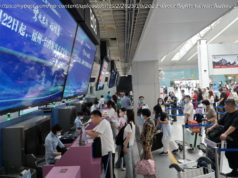China has built hundreds of dazzling new bridges, including the longest and highest, but many have fostered debt and corruption.
CHISHI, China — Soaring over a lush valley in southern China, the Chishi Bridge is a 1.4-mile-long marvel of concrete and steel. Four piers, like graceful tuning forks as tall as skyscrapers, secure cables suspending a four-lane expressway 610 feet above fields of corn and rice.
Squinting up from a dirt road below, Gu Tianyong, a 66-year-old farmer, pondered the colossus, which is a shortcut linking southwestern China with the east coast.
“The government wouldn’ t have built it if it was useless, ” he said. “It does nothing for me, but must be useful for the country.”
The Chishi Bridge is one of hundreds of dazzling bridges erected across the country in recent years. Chinese officials celebrate them as proof that they can roll out infrastructure bigger, better and higher than any other country can. China now boasts the world’s highest bridge, the longest bridge, the highest rail trestle and a host of other superlatives, often besting its own efforts.
The eye-popping structures have slashed travel times in some areas, made business easier and generated a sizable slice of the country’s economy, laying a foundation, in theory at least, for decades of future growth.
But as the bridges and the expressways they span keep rising, critics say construction has become an end unto itself. Fueled by government-backed loans and urged on by the big construction companies and officials who profit from them, many of the projects are piling up debt and breeding corruption while producing questionable transportation benefits.
For all its splendor, the Chishi Bridge, in Hunan Province, exemplifies the seamy underside of China’s infrastructure boom. Its cost, $300 million, was more than 50 percent over the budget. The project struggled with delays and a serious construction accident and was tarnished by government corruption. Since it opened in October, the bridge and the expressway it serves have been underused and buried in debt.
“Infrastructure is a double-edged sword, ” said Atif Ansar, a management professor at the University of Oxford who has studied China’s infrastructure spending. “It’s good for the economy, but too much of this is pernicious. ‘Build it and they will come’ is a dictum that doesn’ t work, especially in China, where there’s so much built already.”
A study that Mr. Ansar helped write said fewer than a third of the 65 Chinese highway and rail projects he examined were “genuinely economically productive, ” while the rest contributed more to debt than to transportation needs. Unless such projects are reined in, the study warned, “poorly managed infrastructure investments” could push the nation into financial crisis.
In the country that built the Great Wall, major feats of infrastructure have long been a point of pride. China has produced engineering coups like the world’s highest railway, from Qinghai Province to Lhasa, Tibet; the world’s largest hydropower project, the Three Gorges Dam; and an 800-mile canal from the Yangtze River system to Beijing that is part of the world’s biggest water transfer project.
Leaders defend the infrastructure spree as crucial to China’s development.
“It’s very important to improve transport and other infrastructure so that impoverished regions can escape poverty and prosper, ” President Xi Jinping said while visiting the spectacular, recently opened Aizhai Bridge in Hunan in 2013. “We must do more of this and keep supporting it.”
Indeed, the new roads and railways have proved popular, especially in wealthier areas with many businesses and heavy commuter traffic. And even empty infrastructure often has a way of eventually filling up, as early critics of the country’s high-speed rail and the Pudong skyscrapers in Shanghai have discovered.
But if the jury is still out on the bridges’ benefits, one can still admire their engineering prowess.
The vertiginous D uge Beipan River Bridge, the world’s highest, vaults a 1,853-foot-deep chasm in southwest China. On the Aizhai Bridge, drivers shoot out of a tunnel to cross a 1,165-foot-deep gorge and then whiz straight into another tunnel. The Qinglong railway bridge carries high-speed trains over a graceful arch 968 feet above the Beipan River in Guizhou Province.
“The amount of high bridge construction in China is just insane, ” said Eric Sakowski, an American bridge enthusiast who runs a website on the world’s highest bridges . “China’s opening, say, 50 high bridges a year, and the whole of the rest of the world combined might be opening 10.”
Of the world’s 100 highest bridges, 81 are in China, including some unfinished ones, according to Mr. Sakowski’s data. (The Chishi Bridge ranks 162nd.)
China also has the world’s longest bridge, the 102-mile Danyang-Kunshan Grand Bridge, a high-speed rail viaduct running parallel to the Yangtze River, and is nearing completion of the world’s longest sea bridge, a 14-mile cable-stay bridge skimming across the Pearl River Delta, part of a 22-mile bridge and tunnel crossing that connects Hong Kong and Macau with mainland China.
The country’s expressway growth has been compared to that of the United States in the 1950s, when the Interstate System of highways got underway, but China is building at a remarkable clip. In 2016 alone, China added 26,100 bridges on roads, including 363 “extra large” ones with an average length of about a mile, government figures show.
China also devotes a much higher share of its economy to building infrastructure than the West — about 9 percent versus about 2.5 percent in the United States and Western Europe, according to the McKinsey Global Institute .
A primary motive is economic growth: Infrastructure spending surged as part of a huge stimulus program after the 2008 global financial crisis. Each bridge can cost billions and employ hundreds of workers for several years.
But the endless construction has also created a self-perpetuating gravy train, feeding corruption and distorting priorities.
While experts often advocate infrastructure building as a path to economic development, local governments in China “went overboard” because of corruption and other financial lures, said Huang Shaoqing, an economist at Shanghai Jiaotong University.
And as gleaming expressways and majestic bridges spread into less populated areas, the cost-benefit ratio of each new mile of asphalt drops sharply.
The Chishi Bridge, for instance, promised “a fast and convenient access to the sea” for southwestern China, a Hunan transportation official, Chen Mingxian, said in 2010, shortly before construction began.
Promising that bridges and expressways could be Hunan’s road to riches, Mr. Chen and other local officials quadrupled the province’s expressways, to 3,778 miles by the end of last year, from 872 miles in 2005.
They were certainly roads to riches for Mr. Chen and his colleagues. In the past six years, anticorruption inquiries have toppled more than 27 Hunan transportation officials.
“In their jurisdiction, they were the emperors, ” a party report said in 2014 .






